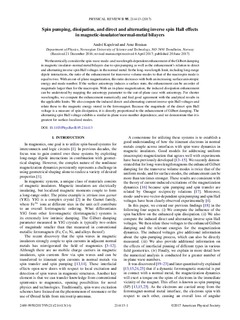| dc.contributor.author | Kapelrud, Andre | |
| dc.contributor.author | Brataas, Arne | |
| dc.date.accessioned | 2018-01-04T11:27:53Z | |
| dc.date.available | 2018-01-04T11:27:53Z | |
| dc.date.created | 2017-10-18T16:47:17Z | |
| dc.date.issued | 2017 | |
| dc.identifier.issn | 1098-0121 | |
| dc.identifier.uri | http://hdl.handle.net/11250/2475582 | |
| dc.description.abstract | We theoretically consider the spin-wave mode- and wavelength-dependent enhancement of the Gilbert damping in magnetic insulator–normal metal bilayers due to spin pumping as well as the enhancement's relation to direct and alternating inverse spin Hall voltages in the normal metal. In the long-wavelength limit, including long-range dipole interactions, the ratio of the enhancement for transverse volume modes to that of the macrospin mode is equal to two. With an out-of-plane magnetization, this ratio decreases with both an increasing surface anisotropic energy and mode number. If the surface anisotropy induces a surface state, the enhancement can be an order of magnitude larger than for the macrospin. With an in-plane magnetization, the induced dissipation enhancement can be understood by mapping the anisotropy parameter to the out-of-plane case with anisotropy. For shorter wavelengths, we compute the enhancement numerically and find good agreement with the analytical results in the applicable limits. We also compute the induced direct- and alternating-current inverse spin Hall voltages and relate these to the magnetic energy stored in the ferromagnet. Because the magnitude of the direct spin Hall voltage is a measure of spin dissipation, it is directly proportional to the enhancement of Gilbert damping. The alternating spin Hall voltage exhibits a similar in-plane wave-number dependence, and we demonstrate that it is greatest for surface-localized modes. | nb_NO |
| dc.language.iso | eng | nb_NO |
| dc.publisher | American Physical Society | nb_NO |
| dc.relation.uri | https://arxiv.org/pdf/1612.07020.pdf | |
| dc.title | Spin pumping, dissipation, and direct and alternating inverse spin Hall effects in magnetic-insulator/normal-metal bilayers | nb_NO |
| dc.type | Journal article | nb_NO |
| dc.type | Peer reviewed | nb_NO |
| dc.description.version | publishedVersion | nb_NO |
| dc.source.volume | 95 | nb_NO |
| dc.source.journal | Physical Review B. Condensed Matter and Materials Physics | nb_NO |
| dc.source.issue | 21 | nb_NO |
| dc.identifier.doi | 10.1103/PhysRevB.95.214413 | |
| dc.identifier.cristin | 1505696 | |
| dc.relation.project | EC/H2020/669442 | nb_NO |
| dc.relation.project | EC/FP7/612759 | nb_NO |
| dc.relation.project | Norges forskningsråd: 239926 | nb_NO |
| dc.description.localcode | © 2017 American Physical Society | nb_NO |
| cristin.unitcode | 194,66,20,0 | |
| cristin.unitname | Institutt for fysikk | |
| cristin.ispublished | true | |
| cristin.fulltext | postprint | |
| cristin.qualitycode | 2 | |
